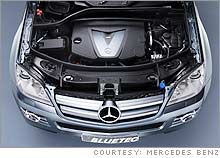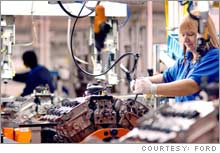|
Diesel: Using oil to cut oil use
The fuel could be the quickest and most efficient way to make a big cut in U.S. oil consumption. But there are problems.
NEW YORK (CNNMoney.com) - Could diesel fuel be the methadone needed to help solve the nation's "oil addiction?" Advocates for diesel -- a less refined fuel than gasoline that burns more completely in the engine, delivering more power -- say it can cut oil use, perhaps more quickly and cost effectively than alternatives such as hybrids and ethanol. Diesels are more fuel efficient than gasoline engines, and often provide greater fuel savings even than the gas-electric hybrid vehicles garnering attention as gas prices have surged. The Environmental Protection Agency estimates that if one-third of cars and light trucks, such as SUVs and minivans, had diesel engines, it would save the equivalent of U.S. oil imports from Saudi Arabia. Diesel fuel is also far more widely available than some alternative fuels such as ethanol that were highlighted by President Bush when lamented the nation's oil addiction in his State of the Union address last month. Nearly half of the nation's filling stations already carry diesel, compared to less than 5 percent that offer an 85-percent ethanol blend known as E85. But new environmental regulations pose a problem for automakers, stopping all of them other than DaimlerChrysler's luxury Mercedes brand from setting a date for a diesel engine introduction in cars and light trucks. Even Volkswagen, which has the largest range of diesel-powered cars and light truck offerings now on the market, may have to pull out of the market at least temporarily, as it can't say when it will be able to meet the new regulations that go into effect with the 2007 model year. It's also not clear how easy it will be to sell diesels to the "green" consumer who might be willing to pay a premium to cut down on emissions. "A lot of education has to take place," said Anthony Pratt of J.D. Power & Associates. "They're not slow and smelly... that they're actually more environmentally friendly than people might think. But our research shows that they're a tough sell to those buyers." Advocates say diesel is close to meeting the new regulations. One reason is that all major automakers already have diesel offerings they sell in Europe, where more than half of cars and light trucks already run on diesel. All those European engines need are modifications to comply with stricter U.S. environmental regulations. "We're not introducing a new technology, we're introducing a new generation of old technology," said Allen Schaeffer, executive director of the Diesel Technology Forum, a trade group of diesel engine manufacturers and automakers. "It's not like the hybrids, where there were none when they first started to be introduced." Weighty matters
Diesels have an inherent advantage over hybrids during highway driving, when the hybrid's electric motor is essentially not in use and thus is extra weight being carried along. Diesel also has some built-in efficiency advantages for heavier vehicles, which is why it is so widely used by buses and large trucks. Therefore, they could see their greatest use in some current gas-guzzling models, such as larger SUVs and pickups, as well as in some luxury vehicles in which the extra cost could be balanced by a buyer's demands for more performance. "The fun-to-drive factor is really high," said Michelle Murad, a spokeswoman for Mercedes USA, which has found stronger-than-anticipated demand for its current diesel offering here. This fall, cleaner low-sulfur fuel will start arriving at those filling stations, holding out the promise of diesel engines that pollute less than many gasoline-powered cars do. And if bio-fuels start to spread in popularity, just about every diesel engine can run a bio-diesel. Right now, only 3 percent of cars and light trucks have diesel engines, and most of those are heavy-duty pickup trucks, such as the Ford F-250, that don't have to meet the same emission standards as smaller trucks and cars. Less than 1 percent of cars and traditional light trucks, such as the F-150, are now diesel, according to figures from the Power Information Network. Those vehicles can't be sold in five states, including California and New York, due to tougher air standards there. "We will not sell a vehicle here unless we can sell in all 50 states," said Ford spokesman Nick Twork. "Part of it is just a business equation -- it's tough to sell vehicles that are closed out to that large a segment of the market." Tougher nationwide
The new regulations will essentially level the playing field nationwide. But they will be much tougher than standards now in effect in the other 45 states, essentially requiring a diesel to be as clean burning as a gasoline-powered car. Part of the problem of complying with the new regulations is that the most cost effective and fuel-efficient way to do so is by injecting urea into the engine. But an engine that runs out of urea would still operate, but would cause more pollution as it continues to run. That would violate EPA regulations requiring emission controls to last more than 100,000 miles without the vehicle owner taking any affirmative steps such as refilling missing fluids. Some diesel advocates are hoping the EPA will relax that rule, allowing car owners to refill their urea tank when they change their oil or fill up with diesel. But it's not clear EPA even has the authority to allow that to happen. Then there is the problem that has limited the spread of most fuel efficiency improvements in the U.S. automotive fleet -- the relatively low price of gasoline here. In Europe, where gasoline is taxed to bring it to more than $5 a gallon and diesel enjoys some tax advantages, there's a lot more incentive for drivers to pull up to the diesel pump. Charlie Freese, General Motors' executive director of diesel engineering, said that even if environmental regulations were identical in Europe and the United States, the difference in fuel prices would keep the use of diesel here well below the European levels. It's also why he won't make projections as to how well diesel vehicles will do in the U.S. "What's driven a lot of the penetration (in Europe) is the fuel price," he said. "My crystal ball is not that clear. If you look at them on economics, the small cars will not provide payback on diesel (at current gas prices). But there are things that diesel does that customers seem to like." -- Details and photos: Diesel vehicles For a look at the promise of ethanol in beating high gasoline prices, click here. For a look at Bush's call for breaking U.S. oil addiction, click here.
For a look at more stories on autos and automakers, click here. |
|



